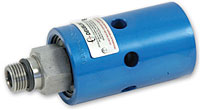With wind turbines, it‚’s crucial to vary the pitch of the rotating blades to maintain constant speed against varying winds in order to generate power. The blades, which rotate with the wind energy, connect to a shaft in the nacelle that is attached through a gearbox to the generator. Through the gearbox, the turbine must rotate at an optimum speed to generate power. Continuous variable pitch control of the blades is necessary to ensure the optimum rotational speed.
Control of the blade pitch can be electric or hydraulic. Electric pitch control systems use slip rings to conduct electricity into the rotating assembly. Hydraulic pitch control systems use a hydraulic rotary union to deliver hydraulic power into the rotating assembly. The industry is split 45/55 between electric and hydraulic pitch control. With hydraulic systems, a hydraulic rotary union is connected at the end of the main shaft to transfer the hydraulic power to the blades to vary
their pitch.


A rotating union is a precision mechanical device used to transfer fluid from a stationary source into a rotating piece of machinery. A typical rotating union has ball bearings to support the rotating component (attached to the machinery) against the stationary component (attached to the stationary supply source) and a mechanical seal to seal the media passing through the rotating union. While often found in wind turbines, this device can be used in a number of applications involving air clutches, gear boxes, machine tool spindles, textile equipment, rubber and plastic manufacturing machinery, and so on.
Deublin Co.
www.deublin.com
::Design World::
Filed Under: Machine tools + subtractive manufacturing, Slip rings + rotary unions, Motion control • motor controls





Tell Us What You Think!